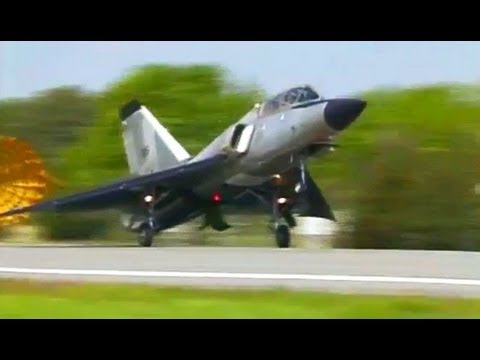more at
An F-106 Delta Dart is used to test leading edge flaps made from composite materials. “New composites that will be used to create lighter yet stronger aircraft wings.”
Public domain film from NASA, slightly cropped to remove uneven edges, with the aspect ratio corrected, and mild video noise reduction applied.
The soundtrack was also processed with volume normalization, noise reduction, clipping reduction, and/or equalization (the resulting sound, though not perfect, is far less noisy than the original).
The Convair F-106 Delta Dart was the primary all-weather interceptor aircraft for the United States Air Force from the 1960s through the 1980s. Designed as the so-called “Ultimate Interceptor”, it has proven to be the last dedicated interceptor in U.S. Air Force service to date. It was gradually retired during the 1980s, with the QF-106 drone conversions of the aircraft being used until 1998…
Fibre-reinforced plastic (FRP) (also fibre-reinforced polymer) is a composite material made of a polymer matrix reinforced with fibres. The fibres are usually glass, carbon, basalt or aramid, although other fibres such as paper or wood or asbestos have been sometimes used. The polymer is usually an epoxy, vinylester or polyester thermosetting plastic, and phenol formaldehyde resins are still in use. FRPs are commonly used in the aerospace, automotive, marine, and construction industries…
Process definition
A polymer is generally manufactured by Step-growth polymerization or addition polymerization. When combined with various agents to enhance or in any way alter the material properties of polymers the result is referred to as a plastic. Composite plastics refer to those types of plastics that result from bonding two or more homogeneous materials with different material properties to derive a final product with certain desired material and mechanical properties. Fibre reinforced plastics are a category of composite plastics that specifically use fibre materials to mechanically enhance the strength and elasticity of plastics. The original plastic material without fibre reinforcement is known as the matrix. The matrix is a tough but relatively weak plastic that is reinforced by stronger stiffer reinforcing filaments or fibres…
History
Bakelite was the first fibre-reinforced plastic. Dr. Baekeland had originally set out to find a replacement for shellac…
The development of fibre reinforced plastic for commercial use was being extensively researched in the 1930s…
Mass production of glass strands was discovered in 1932 when a researcher at Owens-Illinois accidentally directed a jet of compressed air at a stream of molten glass and produced fibres. Owens joined up with the Corning company in 1935 and the method was adapted by Owens Corning to produce its patented “fibreglas” (one “s”). A suitable resin for combining the “fibreglas” with a plastic was developed in 1936 by du Pont. The first ancestor of modern polyester resins is Cyanamid’s of 1942. Peroxide curing systems were used by then.
Ray Greene of Owens Corning is credited with producing the first composite boat in 1937…
The first fibre reinforced plastic plane fuselage was used on a modified Vultee BT-13A designated the XBT-16 based at Wright Field in late 1942. In 1943 further experiments were undertaken building structural aircraft parts from composite materials resulting in the first plane, a Vultee BT-15, with a GFRP fuselage, designated the XBT-19, being flown in 1944. A significant development in the tooling processes for GFRP components had been made by Republic Aviation Corporation in 1943.
Carbon fibre production began in the late 1950s and was used, though not widely, in British industry beginning in the early 1960s, aramid fibres were being produced around this time also, appearing first under the trade name Nomex by DuPont. Today each of these fibres is used widely in industry for any applications that require plastics with specific strength or elastic qualities. Glass fibres are the most common across all industries, although carbon fibre and carbon fibre aramid composites are widely found in aerospace, automotive and sporting good applications.
Global polymer production on the scale present today began in the mid 20th century, when low material and productions costs, new production technologies and new product categories combined to make polymer production economical. The industry finally matured in the late 1970s when world polymer production surpassed that of Steel, making polymers the ubiquitous material that it is today. Fibre reinforced plastics have been a significant aspect of this industry from the beginning. There are three important categories of fibre used in FRP, glass, carbon, and aramid…

